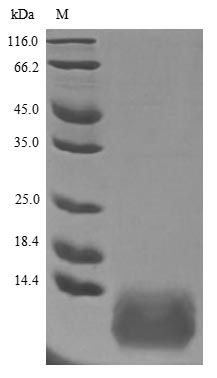Recombinant Human Trefoil factor 3 (TFF3) is produced using a yeast expression system and provided as a partial protein covering the 29-80 amino acid region. The protein includes an N-terminal 6xHis-tag, which streamlines purification and detection processes. This product achieves purity greater than 90% as confirmed by SDS-PAGE analysis, suggesting reliable performance for research applications.
Trefoil factor 3 (TFF3) belongs to the trefoil factor family and appears to play a crucial role in mucosal protection and repair. It primarily maintains the integrity of epithelial surfaces. Researchers study TFF3 for its potential involvement in wound healing and mucosal defense, making it an important focus in gastrointestinal research and epithelial biology.
Potential Applications
Note: The applications listed below are based on what we know about this protein's biological functions, published research, and experience from experts in the field. However, we haven't fully tested all of these applications ourselves yet. We'd recommend running some preliminary tests first to make sure they work for your specific research goals.
Based on the provided information, recombinant human TFF3 is produced in a yeast expression system as a partial fragment (29-80aa) with an N-terminal 6xHis-tag. TFF3 is a small secretory protein that requires precise folding and disulfide bond formation for its biological activity in mucosal protection and repair. Yeast expression systems provide eukaryotic folding machinery capable of supporting disulfide bond formation, which is critical for TFF3's stability and function. However, the partial nature of the fragment (missing the signal peptide and potentially critical regions) and the presence of the His-tag may affect proper folding. No validation data (e.g., receptor binding assays, circular dichroism) are provided. Therefore, while yeast expression increases the probability of correct folding compared to prokaryotic systems, the protein's folding status and bioactivity cannot be confirmed without experimental validation.
1. Antibody Development and Validation Studies
This application is suitable as antibody generation primarily relies on linear epitope recognition, which is independent of folding status. The high purity and defined fragment support consistent immunization results. However, if correctly folded, antibodies may recognize conformational epitopes relevant to native TFF3; if misfolded, generated antibodies might not optimally bind the full-length protein in biological contexts, limiting utility for functional studies.
2. Protein-Protein Interaction Studies
If correctly folded, the His-tagged TFF3 fragment could be used in pull-down assays to identify binding partners, as proper folding is essential for biologically relevant interactions. However, if misfolded, interaction domains may be altered, leading to non-specific binding or failure to recognize genuine biological partners. The partial nature may also lack key interaction sites present in full-length TFF3.
3. Structural and Biochemical Characterization
If properly folded, the fragment is suitable for limited structural studies of this specific domain. However, if misfolded, structural data would misrepresent the native protein's architecture. The small size and His-tag may limit insights into full-length TFF3 behavior and interfere with some structural analyses.
4. ELISA Standard and Quantification Assays
If correctly folded, the recombinant TFF3 can serve as a standard in ELISA assays for quantification. However, if misfolded, it may not accurately represent native protein epitopes, potentially leading to inaccurate standard curves. The His-tag can be used for capture, but may affect antibody binding if the tag interferes with epitope presentation.
Final Recommendation & Action Plan
Before employing this recombinant TFF3 fragment in any application, it is essential to validate its folding and bioactivity through biophysical methods (e.g., circular dichroism for secondary structure, mass spectrometry for disulfide bond analysis) and functional assays (e.g., receptor binding or cell migration assays); if validation confirms proper folding and function, proceed with applications while noting the limitations of the partial fragment; if misfolded, consider using full-length TFF3 expressed in mammalian systems for better physiological relevance or obtain a commercially validated standard; for immediate use, antibody development can proceed with the understanding that antibodies may require additional validation against native protein; avoid functional studies until proper folding is confirmed. Always include appropriate controls (e.g., native TFF3, known ligands) in experiments to ensure reliability.






